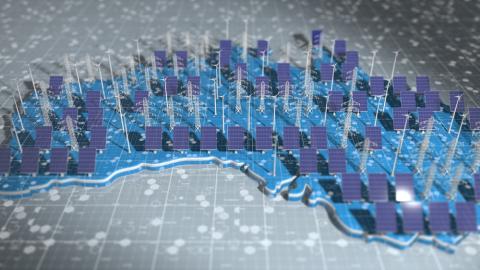The seven technology disruptions driving the global energy transition
Download Full Report
Key Findings
Four of the seven disruptions are primarily generation-side disruptions; three are grid-side.
In the U.S., electricity demand has been flat for a decade despite an ongoing economic expansion. This is the result in part of more efficient appliances, machines and lighting, changes all spurred by energy policy initiatives from years ago that are now paying off.
The rise of renewables—specifically wind and solar—is often seen as a single disruption, but should be seen as two distinct disruptions, each driven by different kinds of technology advances.
Another type of electricity-generation disruption comes as a result of the now-dominant use of horizontal drilling and hydraulic fracturing (known as fracking) for natural gas and oil production, a disruption that—alongside the rise of renewables—has driven down the price of electricity generation and made coal-fired generation uncompetitive.
Executive Summary
The mix of fuels used for generating electricity around undergoing a fundamental global change. Coal, which ushered in the electric age over 140 years ago and has been the dominant fuel for electrification until only recently, is now being rapidly replaced by natural gas, wind and solar as a worldwide push for electricity modernization intensifies.
At the same time, economic growth in many nations is no longer tied to increases in the consumption of fuel, as energy efficiency has increased and as the sectors leading economic expansions are less energy intensive than the heavy industries of the past.
A third trend is also gaining ground: “The electrification of everything,” where electricity— rather than other forms of energy—is powering more and more aspects of commercial, industrial, and consumer life. This trend is seen most obviously in transportation, where the impact of electric vehicles is still small but is on course to completely transform the sector in the coming years.
The chart above shows how—even with most coal produced in the U.S. going to the electricity sector—power generation is becoming less and less dependent on coal.
Natural gas and renewables are gaining market share, as coal’s footprint shrinks and as contributions from hydro and nuclear power remain more or less flat. These trends combined—the rise of renewables and natural gas, the decline of coal, the relative stability of hydro and nuclear—are collectively driving the transition in electricity generation and distribution.
But the energy transition described here is about more than just natural gas or renewables replacing coal: IEEFA is following seven fundamental technology disruptions that are driving this transformation. Significantly, all of them are contributing in different ways to a terminal decline in coal use, even though each is at a slightly different stage of development.
Four of the seven disruptions are primarily generation-side disruptions; three are grid-side.
Press release: Global Energy Markets Transition Drives Thermal Coal Into Structural Decline
Please view full report PDF for references and sources.















